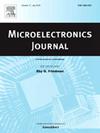On-chip Wi-Fi filter with FBW of 16.3 % and IL of 1.8 dB using novel T-type transmission zeros structure
IF 1.9
3区 工程技术
Q3 ENGINEERING, ELECTRICAL & ELECTRONIC
引用次数: 0
Abstract
A novel T-type topology is proposed for the first time to generate a pair of transmission zeros (TZs), enabling a wide range of resistive band rejection within a specific range. The working mechanism is elucidated through its even- and odd-mode equivalent circuits, and the design process is outlined. Moreover, an enhanced third-order high-pass filter is integrated with the T-type circuit to form a bandpass filter (BPF). This proposed BPF is fabricated using on-chip integrated passive device (IPD) technology. The measured and simulated results confirm its performance. Notably, the proposed IPD BPF has fractional bandwidth (FBW) of only 16.3 % and an insertion loss (IL) of 1.8 dB within the passband, thereby making it promising for narrowband applications. In addition, its compact size makes it suitable for Wi-Fi applications.
采用新型 T 型传输零点结构的片上 Wi-Fi 滤波器,FBW 为 16.3%,IL 为 1.8 dB
首次提出了一种新颖的 T 型拓扑结构,用于产生一对传输零点(TZ),从而在特定范围内实现大范围的电阻带抑制。通过其偶模和奇模等效电路阐明了工作机制,并概述了设计过程。此外,还将增强型三阶高通滤波器与 T 型电路集成,形成带通滤波器 (BPF)。这种拟议的 BPF 是利用片上集成无源器件(IPD)技术制造的。测量和模拟结果证实了它的性能。值得注意的是,所提出的 IPD BPF 的分数带宽(FBW)仅为 16.3%,通带内的插入损耗(IL)为 1.8 dB,因此非常适合窄带应用。此外,它体积小巧,适合 Wi-Fi 应用。
本文章由计算机程序翻译,如有差异,请以英文原文为准。
求助全文
约1分钟内获得全文
求助全文
来源期刊

Microelectronics Journal
工程技术-工程:电子与电气
CiteScore
4.00
自引率
27.30%
发文量
222
审稿时长
43 days
期刊介绍:
Published since 1969, the Microelectronics Journal is an international forum for the dissemination of research and applications of microelectronic systems, circuits, and emerging technologies. Papers published in the Microelectronics Journal have undergone peer review to ensure originality, relevance, and timeliness. The journal thus provides a worldwide, regular, and comprehensive update on microelectronic circuits and systems.
The Microelectronics Journal invites papers describing significant research and applications in all of the areas listed below. Comprehensive review/survey papers covering recent developments will also be considered. The Microelectronics Journal covers circuits and systems. This topic includes but is not limited to: Analog, digital, mixed, and RF circuits and related design methodologies; Logic, architectural, and system level synthesis; Testing, design for testability, built-in self-test; Area, power, and thermal analysis and design; Mixed-domain simulation and design; Embedded systems; Non-von Neumann computing and related technologies and circuits; Design and test of high complexity systems integration; SoC, NoC, SIP, and NIP design and test; 3-D integration design and analysis; Emerging device technologies and circuits, such as FinFETs, SETs, spintronics, SFQ, MTJ, etc.
Application aspects such as signal and image processing including circuits for cryptography, sensors, and actuators including sensor networks, reliability and quality issues, and economic models are also welcome.
 求助内容:
求助内容: 应助结果提醒方式:
应助结果提醒方式:


